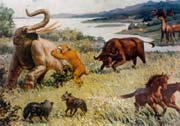|
During the entire Pleistocene, the distribution of fossils of giant panda subspecies is rather wide. The distribution almost covers the east and south of China, to the north including the Zhou Koudian site and to the south including Taiwan Island as well as Burma, Vietnam and North Thailand. In those remote ages, the giant panda had been living with the Smilodon, the Stegodon Sinensis Owen, the Peking Man and the Australopithecus, which formed the typical Pleistocene - Giant Panda - Stegodon Sinensis Owen fossil cluster. During the mid and late Pleistocene Period, great environment changes had occurred as large areas of glacier appeared in the Qingling Mountains and those mountains to the south. After the Quarternary Glacier, which is about 18 thousand years ago, the Giant Panda - Stegodon Sinensis Owen fauna declined, most of the animals became extinct, and only those innumerable fossils indicated their existence. The giant panda disappeared in the north, and the distribution of giant panda in the south also shrank. Giant Pandas thereafter stepped into the declining stage of evolutionary history.
 
A Picture of Giant Panda's Evolutionary History and Fossil Evidences
The current situation of Giant Pandas
|



